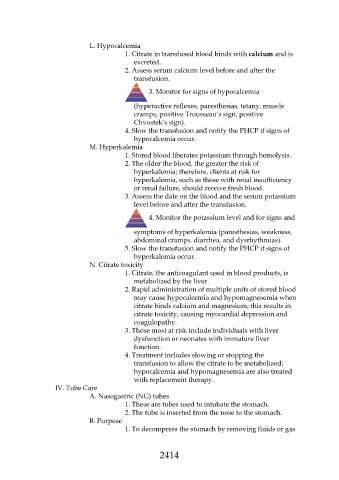Page 2414 - Saunders Comprehensive Review For NCLEX-RN
P. 2414
L. Hypocalcemia
1. Citrate in transfused blood binds with calcium and is
excreted.
2. Assess serum calcium level before and after the
transfusion.
3. Monitor for signs of hypocalcemia
(hyperactive reflexes, paresthesias, tetany, muscle
cramps, positive Trousseau’s sign, positive
Chvostek’s sign).
4. Slow the transfusion and notify the PHCP if signs of
hypocalcemia occur.
M. Hyperkalemia
1. Stored blood liberates potassium through hemolysis.
2. The older the blood, the greater the risk of
hyperkalemia; therefore, clients at risk for
hyperkalemia, such as those with renal insufficiency
or renal failure, should receive fresh blood.
3. Assess the date on the blood and the serum potassium
level before and after the transfusion.
4. Monitor the potassium level and for signs and
symptoms of hyperkalemia (paresthesias, weakness,
abdominal cramps, diarrhea, and dysrhythmias).
5. Slow the transfusion and notify the PHCP if signs of
hyperkalemia occur.
N. Citrate toxicity
1. Citrate, the anticoagulant used in blood products, is
metabolized by the liver.
2. Rapid administration of multiple units of stored blood
may cause hypocalcemia and hypomagnesemia when
citrate binds calcium and magnesium; this results in
citrate toxicity, causing myocardial depression and
coagulopathy.
3. Those most at risk include individuals with liver
dysfunction or neonates with immature liver
function.
4. Treatment includes slowing or stopping the
transfusion to allow the citrate to be metabolized;
hypocalcemia and hypomagnesemia are also treated
with replacement therapy.
IV. Tube Care
A. Nasogastric (NG) tubes
1. These are tubes used to intubate the stomach.
2. The tube is inserted from the nose to the stomach.
B. Purpose
1. To decompress the stomach by removing fluids or gas
2414

